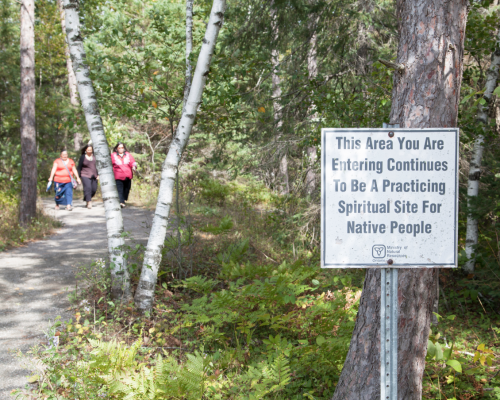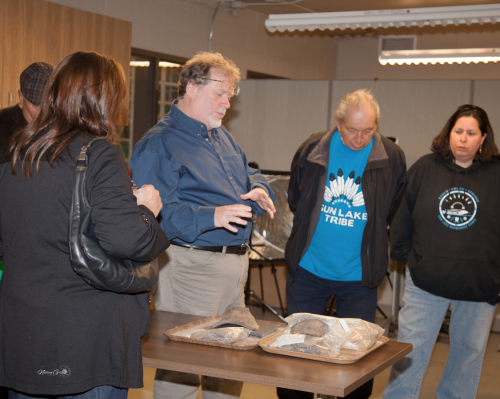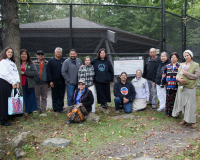For the Saginaw Chippewa Indian Tribe of Michigan, ezhibiigaadek asin is a sacred place, where over 100 petroglyphs convey teachings from their Anishinabe ancestors. The Michigan Archaeological Society (MAS) holds the deed to the land, and the site is managed by the State of Michigan’s Department of Natural Resources (DNR), who retain the keys to the locked 12-foot fence around ezhibiigaadek asin.
Concerns around the management and protection of the site and its associated intellectual property prompted Shannon Martin, Director of the Ziibiwing Center of Anishinabe Culture & Lifeways, and Dr. Sonya Atalay, an Anishinabe-Ojibwe archaeologist then at Indiana University, to develop an IPinCH-supported project related to ezhibiigaadek asin. The initiative focuses on the development of a co-management strategy that will take into account the intellectual properties — the images, stories, lifeways, ceremonies, interpretations, research data, and so on — associated with ezhibiigaadek asin.
 Though the project officially began in early 2009, challenges related to funding transfers and ethics board approvals significantly slowed progress, especially after Sonya moved to the University of Massachusetts-Amherst, and new transfers and approvals were required. With these complications now behind them, the project has leapt forward over the last few months.
Though the project officially began in early 2009, challenges related to funding transfers and ethics board approvals significantly slowed progress, especially after Sonya moved to the University of Massachusetts-Amherst, and new transfers and approvals were required. With these complications now behind them, the project has leapt forward over the last few months.
In June 2014, the project team, including Sonya, Shannon, Ziibiwing’s curator William Johnson, newly-appointed Saginaw Chippewa Tribal Historic Preservation Officer, John Graveratte, and graduate student assistants (Saginaw Chippewa tribal member Frank Raslich, his wife Nicole Raslich and Stacy Tchorzynski), gathered with Elders and spiritual leaders at the Ziibiwing Center of Anishinabe Culture & Lifeways to revisit their earlier strategic plan, which mapped out their project goals and timelines. The two-day meeting was an opportunity to reassess their original strategy of community engagement and research, following the resolution of university bureaucratic challenges.
The project team is excited to report that a number of encouraging conversations have now taken place between the tribal community, MAS, and the DNR. The DNR has expressed their openness to working towards developing long-standing special permits to give the Saginaw Chippewa Indian Tribe their own key to the locked ezhibiigaadek asin site, and several constructive meetings have taken place with MAS as well. Somewhat ironically, the delays in this project have worked in favor of its overall goals.
Stacy Tchorzynski, one of the graduate research assistants on this project, was also recently employed as an archaeologist with the State Historic Preservation Office and the Michigan Historical Center, a division of the DNR. In this role, she is charged with identifying, protecting and interpreting Michigan’s archaeological sites. Stacy’s Ph.D. dissertation (supervised by IPinCH team member Randy McGuire) explores the process of sharing access to and engaging collaboratively with the ezhibiigaadek asin site. The fact that Stacy is on the ezhibiigaadek asin project team and has extensive understanding of the importance of the site for the Saginaw Chippewa Indian Tribe, and is also employed by the DNR, is promising for the facilitation of future conversations. The project team is looking forward to seeing how their partnerships with DNR and MAS develop.
 In September, the project team embarked on a road trip across the border to Canada. From September 15th-18th, Sonya, Shannon, their graduate research assistants, and a group of Elders and spiritual leaders travelled through southern Ontario. The first stop was a visit to Neal Ferris’ Sustainable Archaeology project facilities. Sustainable Archaeology is a collaborative initiative between the University of Western Ontario, in London, Ontario, and McMaster University, in Hamilton, Ontario, to advance a sustainable form of archaeological practice and research.
In September, the project team embarked on a road trip across the border to Canada. From September 15th-18th, Sonya, Shannon, their graduate research assistants, and a group of Elders and spiritual leaders travelled through southern Ontario. The first stop was a visit to Neal Ferris’ Sustainable Archaeology project facilities. Sustainable Archaeology is a collaborative initiative between the University of Western Ontario, in London, Ontario, and McMaster University, in Hamilton, Ontario, to advance a sustainable form of archaeological practice and research.
Next, the group travelled to Peterborough, Ontario, to Petroglyphs Provincial Park. Here they met with members of the Curve Lake Anishinaabe community, for whom the petroglyphs site is sacred, as well as delegates from the Province. The Peterborough petroglyphs site is co-managed by both parties, and the Province has established positive partnerships with the tribal community. The visitor centre and the interpretation of the rock carvings is managed by the Curve Lake First Nation.
The ezhibiigaadek asin project team is keen to learn from those with experience co-managing rock art sites. It has been difficult for the group to locate many such sites in North America, and this made the Peterborough Petroglyphs visit all the more significant. The project team previously worked with their elders to come up with a list of concerns and questions regarding how information about ezhibiigaadek asin should be shared, what information is appropriate to share, and what the protocols should be. The group then sat down with those co-managing the Peterborough site to see how they deal with these issues. The team also invited Michigan state archaeologists to come along for the trip.
On their return to Michigan, the group stopped for a visit to the ezhibiigaadek asin site.
Another key element of this project is reinstituting traditional cultural practices associated with ezhibiigaadek asin, including fasting camps, rites of passage, and customs associated with the “little people” (paisug) who inhabit this site. Sonya has committed to a four-day fast next spring, and there are plans to bring youth out to prepare a feasting bundle for the little people. In addition to reviving these important practices, the hope is that the state and landowners will increasingly acknowledge the significance of this site for the Saginaw Chippewa peoples.
There has also been a renewed commitment to involve youth in the project. Given that many tribal youth are interested in filmmaking, the project team has invited them to spearhead a documentary project related to the ezhibiigaadek asin site. Some tribal youth have already participated in workshops and training with the Sundance Institute. Connecting youth with Elders involved in the project also facilitates the sharing of intergenerational knowledge, deemed crucially important to the future protection and management of ezhibiigaadek asin.
The project team is also developing a survey to be distributed to tribal members and Anishinabe people before the end of the year. This survey will ask broad questions about ezhibiigaadek asin, such as “what cultural information do you think is appropriate to share?” and “how do you think this site should be cared for?” The survey, which will be distributed online via SurveyMonkey and in paper format at local events, will provide valuable feedback about community and individual values and opinions.
Sonya is also planning a roundtable forum at the upcoming Society for American Archaeology’s Annual Meeting, which will bring together scholars and community experts to discuss the challenges of working with state and federal bodies in the co-management of rock art sites. The hope is to connect representatives from the Saginaw Chippewa Indian Tribe, with those from the Ngaut Ngaut site in Australia, as well as the Curve Lake community in Peterborough.
Keep a look out for more exciting developments to come related to the ezhibiigaadek asin project.
Photos: The project team visits the ezhibiigaadek asin site in Michigan (top), as well as Petroglyphs Provincial Park, near Peterborough, Ontario (middle), and Neal Ferris’ Sustainable Archaeology project facilities (bottom) (photos: Niibing Giizis Studio).
Kristen Dobbin is the IPinCH Communication Specialist.






